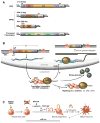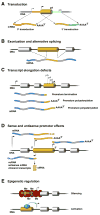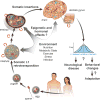LINE-1 retrotransposons: mediators of somatic variation in neuronal genomes?
- PMID: 20471112
- PMCID: PMC2916067
- DOI: 10.1016/j.tins.2010.04.001
LINE-1 retrotransposons: mediators of somatic variation in neuronal genomes?
Abstract
LINE-1 (L1) elements are retrotransposons that insert extra copies of themselves throughout the genome using a 'copy and paste' mechanism. L1s comprise nearly approximately 20% of the human genome and are able to influence chromosome integrity and gene expression upon reinsertion. Recent studies show that L1 elements are active and 'jumping' during neuronal differentiation. New somatic L1 insertions could generate 'genomic plasticity' in neurons by causing variation in genomic DNA sequences and by altering the transcriptome of individual cells. Thus, L1-induced variation could affect neuronal plasticity and behavior. We discuss potential consequences of L1-induced neuronal diversity and propose that a mechanism for generating diversity in the brain could broaden the spectrum of behavioral phenotypes that can originate from any single genome.
Copyright 2010 Elsevier Ltd. All rights reserved.
Conflict of interest statement
The authors declare no conflict of interest.
Figures



Similar articles
-
L1 retrotransposons and somatic mosaicism in the brain.Annu Rev Genet. 2014;48:1-27. doi: 10.1146/annurev-genet-120213-092412. Epub 2014 Jul 14. Annu Rev Genet. 2014. PMID: 25036377 Review.
-
Long interspersed element-1 (LINE-1): passenger or driver in human neoplasms?PLoS Genet. 2013 Mar;9(3):e1003402. doi: 10.1371/journal.pgen.1003402. Epub 2013 Mar 28. PLoS Genet. 2013. PMID: 23555307 Free PMC article. Review.
-
[Genomic instability associated with human LINE-1 rétrotransposition].J Soc Biol. 2004;198(4):419-24. J Soc Biol. 2004. PMID: 15969349 Review. French.
-
LINE-1 retrotransposons contribute to mouse PV interneuron development.Nat Neurosci. 2024 Jul;27(7):1274-1284. doi: 10.1038/s41593-024-01650-2. Epub 2024 May 21. Nat Neurosci. 2024. PMID: 38773348 Free PMC article.
-
Dynamic Methylation of an L1 Transduction Family during Reprogramming and Neurodifferentiation.Mol Cell Biol. 2019 Mar 19;39(7):e00499-18. doi: 10.1128/MCB.00499-18. Print 2019 Apr 1. Mol Cell Biol. 2019. PMID: 30692270 Free PMC article.
Cited by
-
Single cell genomics of the brain: focus on neuronal diversity and neuropsychiatric diseases.Curr Genomics. 2012 Sep;13(6):477-88. doi: 10.2174/138920212802510439. Curr Genomics. 2012. PMID: 23449087 Free PMC article.
-
Induced pluripotent stem cells to model and treat neurogenetic disorders.Neural Plast. 2012;2012:346053. doi: 10.1155/2012/346053. Epub 2012 Jul 19. Neural Plast. 2012. PMID: 22888453 Free PMC article. Review.
-
Retrotransposon-induced mosaicism in the neural genome.Open Biol. 2018 Jul;8(7):180074. doi: 10.1098/rsob.180074. Open Biol. 2018. PMID: 30021882 Free PMC article. Review.
-
Melatonin: Regulation of Viral Phase Separation and Epitranscriptomics in Post-Acute Sequelae of COVID-19.Int J Mol Sci. 2022 Jul 23;23(15):8122. doi: 10.3390/ijms23158122. Int J Mol Sci. 2022. PMID: 35897696 Free PMC article. Review.
-
Transcript catalogs of human chromosome 21 and orthologous chimpanzee and mouse regions.Mamm Genome. 2011 Jun;22(5-6):261-71. doi: 10.1007/s00335-011-9321-y. Epub 2011 Mar 13. Mamm Genome. 2011. PMID: 21400203
References
-
- McClintock B. Chromosome organization and genic expression. Cold Spring Harb Symp Quant Biol. 1951;16:13–47. - PubMed
-
- Comfort NC. “The real point is control”: the reception of Barbara McClintock’s controlling elements. J Hist Biol. 1999;32(1):133–62. - PubMed
-
- Gotea V, Makalowski W. Do transposable elements really contribute to proteomes? Trends Genet. 2006;22(5):260–7. - PubMed
Publication types
MeSH terms
Substances
Grants and funding
LinkOut - more resources
Full Text Sources
Other Literature Sources

